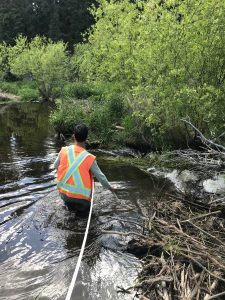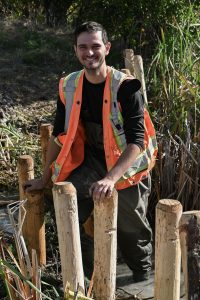
Beavers are industrious engineers in the animal kingdom and play a vital role in maintaining healthy ecosystems. Beaver dams create wetlands, which serve as crucial habitats for a diverse range of species and help to regulate water flow and mitigate the effects of floods and droughts. Understanding where to focus beaver-based restoration for habitat and climate change mitigation is critical, and that’s precisely what a recent project undertaken by Alessandro Freeman, BCIT student in the Masters of Ecological Restoration program, aimed to do.
Under the supervision of BCIT School of Construction and the Environment researcher Doug Ransome and in collaboration with Ducks Unlimited Canada, Alessandro Freeman set out to assess the effectiveness of a Geographic Information System (GIS) habitat model in identifying suitable locations for beaver-dam construction. The project, funded by the Mitacs Accelerate program and the Al Martin Habitat Conservation Trust Foundation (HCTF) fellowship, focused on using the Beaver Restoration Assessment Tool (BRAT) to pinpoint watercourses with high beaver habitat potential in the Cariboo Region of British Columbia.

Using beavers to create and maintain wetlands, restore water flows, and restoring some of the most ecologically diverse habitats is an excellent example of nature-based processes. Mimicking how beavers build extensive wetlands saves money, restores critical ecological function to flood plains, creates important habitat for fish, amphibians, waterfowl, and for large species like moose. It is a perfect marriage between natural processes and ecological restoration.
BRAT summer
The BRAT, originally developed by Utah State University, evaluates various factors such as riverbank and wetland area vegetation, stream physical characteristics, and stream hydrology to estimate a stream’s dam capacity. Alessandro’s work involved testing the accuracy of this tool by comparing its outputs with field measurements taken at the streams in the Cariboo region. Additionally, he employed climate data with the BRAT’s hydrological outputs to model changes in stream flow, crucial for understanding the long-term viability of beaver habitats in the face of climate change.

The results of Alessandro’s research sheds light on the BRAT’s capabilities and limitations for use in BC. “Overall, the BRAT was able to estimate the availability of preferred vegetation for beaver and accurately separated dam capacity based on vegetation,” says Alessandro. “It also identified streams with physical restrictions such as high gradient. However, the BRAT often overestimated water availability, with several streams being dry at time of assessment. Several streams with high dam capacity also scored poorly in overall habitat quality compared to other streams with low dam capacity.” These findings suggest that dam capacity alone is insufficient in finding sites with the highest chance of successful beaver occupation.
“Alessandro’s research is very timely,” says Doug Ransome. “Using and refining the BRAT tool, among others, are at the forefront of initiating field research trials in western Canada. Working with Ducks Unlimited and restoration practitioners and leaders, including Indigenous communities, BC Wildlife Federation, government, and NGOs, provides an excellent opportunity to study how well mimicking beavers will enhance our restoration goals in riparian and wetland environments.”
Doug adds, “Using the BRAT tool and other tools like beaver dam analogues will significantly enhance our ability to implement and assess this novel approach to wetland restoration. There will be a large team of graduate students working to assess, adapt, and refine this novel approach, to meet the needs of society.”
The power of applied research
Mitacs Accelerate scholarships pair industry partners and students to overcome innovation challenges through applied research projects. Students complete research and develop tools, models, technology, or solutions to support the host business’s challenges. By harnessing the expertise of students like Alessandro, innovative solutions can be developed to solve all types of industry problems.
“Working on this applied research project developed my practical skills as a scientist immensely from overseeing an entire project from beginning to end. Thinking of research questions, methods to test the hypothesis, gathering field data, completing analysis, and technical writing are all incredibly important skills to improve that are not always gained in a typical class-based course,” says Alessandro.
The value of applied research projects like these for a student’s education and future career is immense. Applied research projects create practical learning opportunities, build industry connections, provide innovative solutions to industry challenges and produce new technologies and processes.
Applied research is at the heart of student learning
Applied research is at the heart of what makes BCIT unique. Integrated across all BCIT schools and programs, student applied research goes by many names —experiential learning, work-integrated learning (WIL), capstone projects, directed studies, and industry-sponsored student projects (ISSP). Whatever it’s called, the impact is undeniable.
Through applied research, students work on real-world challenges, gaining practical experience that is invaluable for their future careers. These hands-on projects not only enhance learning but also build direct connections with industry, foster innovation, and lead to the development of new technologies. Each year, BCIT students participate in thousands of applied research projects, solving complex industry problems while contributing fresh, innovative solutions.
BCIT stands apart by embedding applied research into the education of most students, particularly those in programs of two years or longer. This unique approach ensures that graduates are prepared for the workforce and have a strong industry network and the skills to drive innovation in their fields.

Bravissimo Alessandro!
Somebody has clearly been beavering away! What a great project!